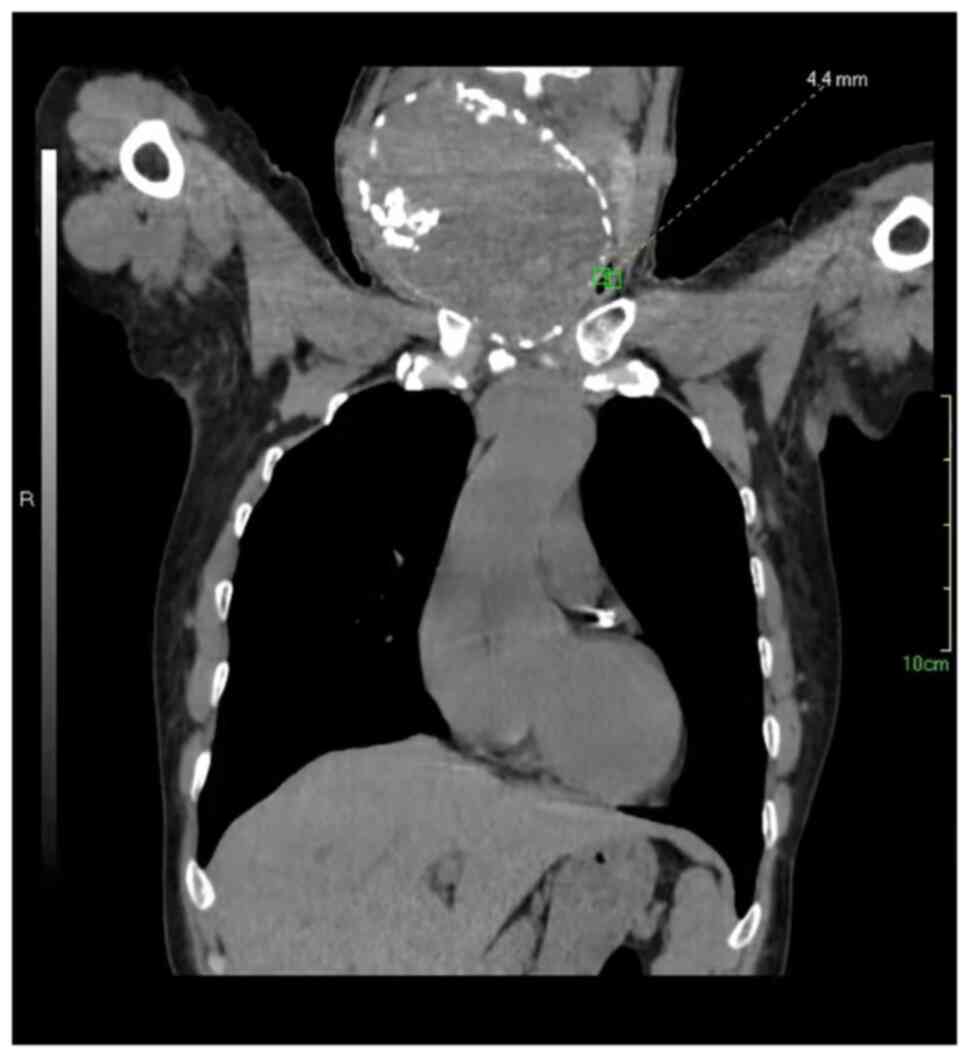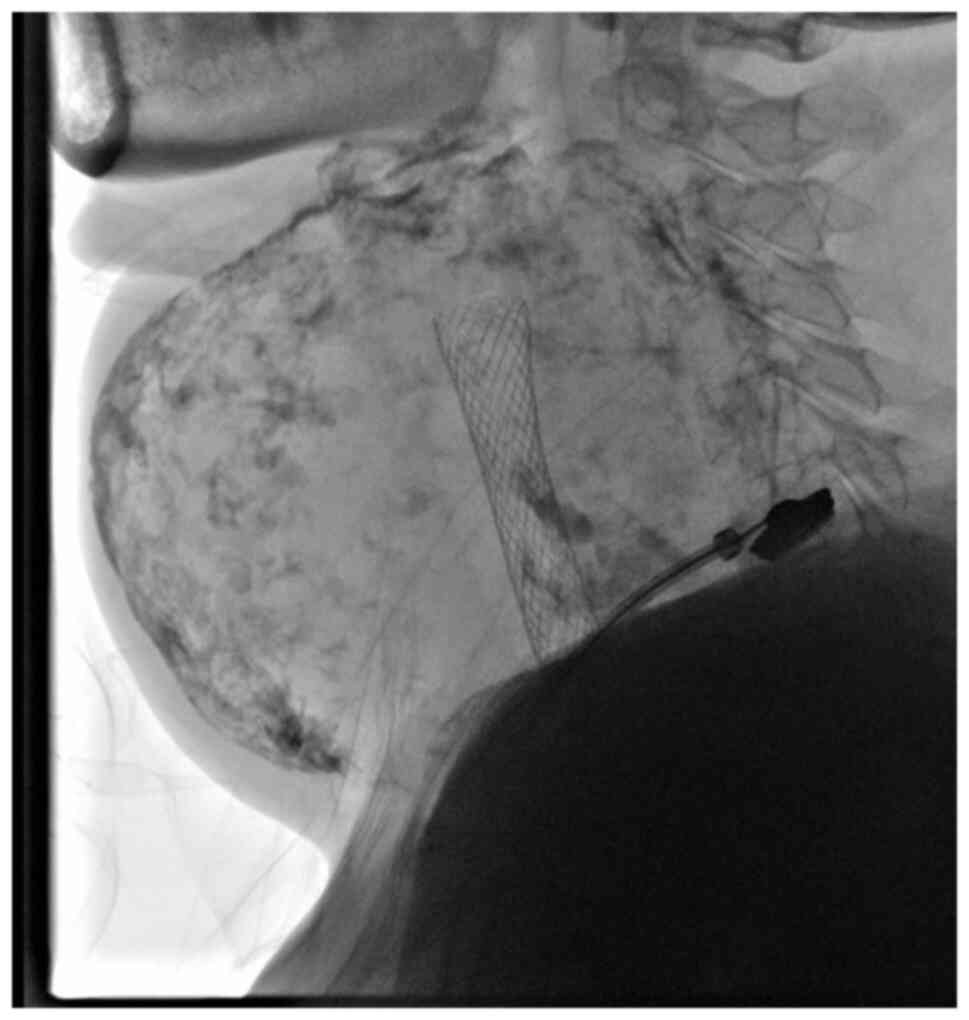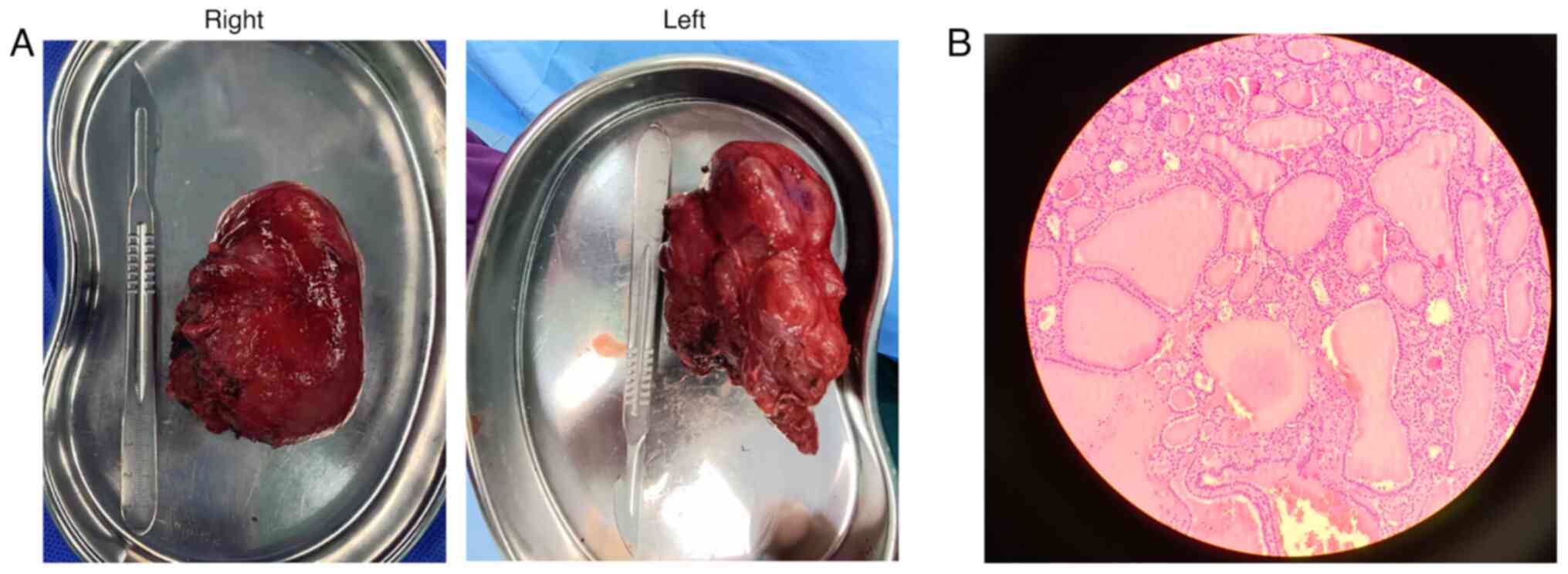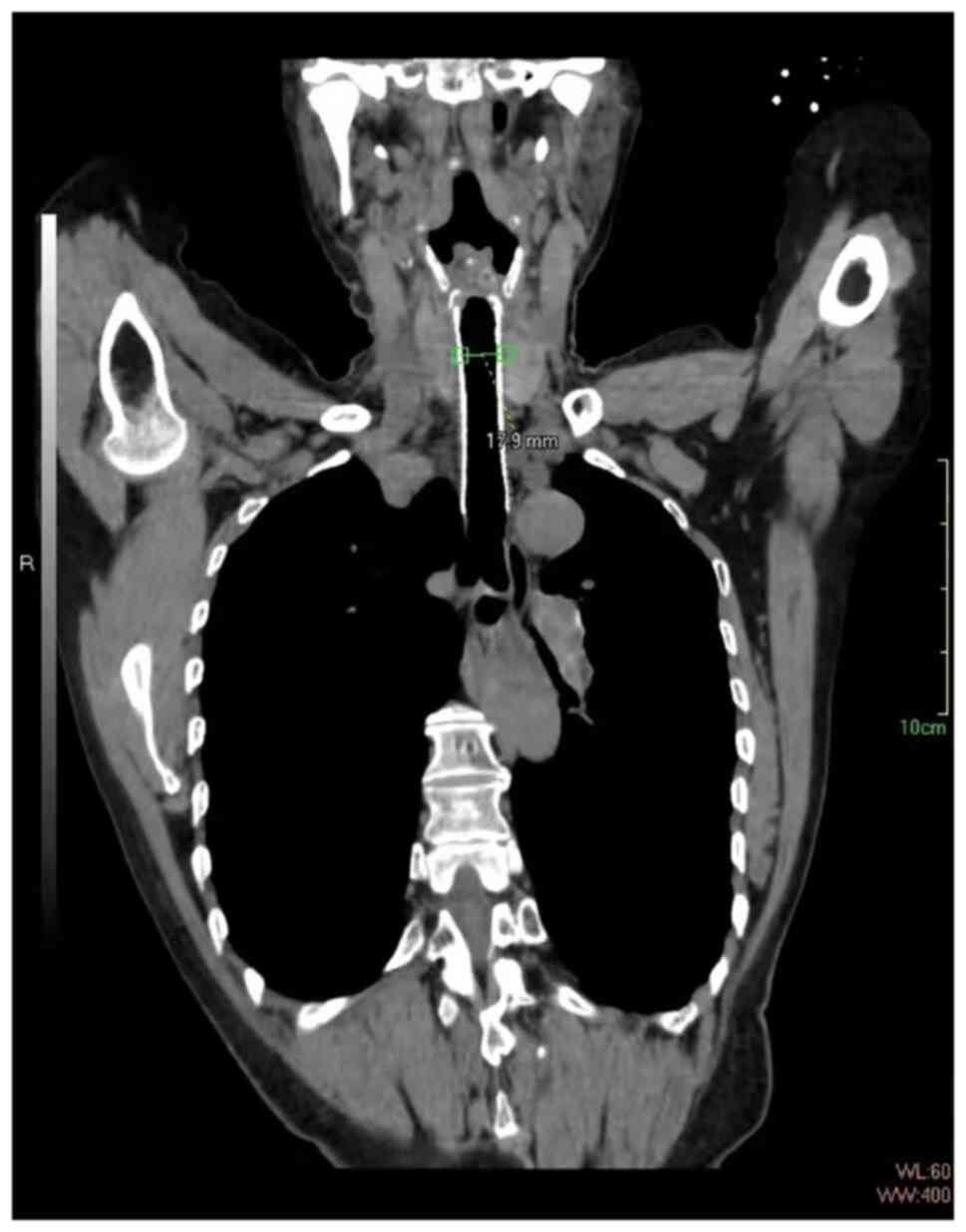A new treatment strategy for airway obstruction induced by a giant benign goiter: A case report
- Authors:
- Published online on: June 23, 2023 https://doi.org/10.3892/etm.2023.12075
- Article Number: 376
-
Copyright: © Zhu et al. This is an open access article distributed under the terms of Creative Commons Attribution License.
Abstract
Introduction
Thyroid disease with significant airway obstruction is a rare occurrence, with an incidence rate of about 1-2% in thyroid patients (1). Numerous cases of the combination of thyroid disease and airway obstruction occur along with thyroid cancer (1). However, a large benign goiter may also be associated with severe acute airway obstruction (2). Significant airway obstruction can induce severe respiratory distress and requires immediate action for the prompt restoration of the airway passage (3). In severe respiratory distress, an emergency thyroidectomy is required (3). However, an emergency thyroidectomy in individuals with dyspnea can increase the risk of surgical complications such as hemorrhage, recurrent laryngeal nerve injury and hypoparathyroidism (3). Therefore, an alternative effective therapeutic strategy is necessary to avoid such complications.
In the present study, a rare case of acute airway compression induced by a giant goiter was reported. Treatment of this case involved placement of a self-expanding metal stent to relieve dyspnea. Following stent placement, a thyroidectomy and subsequent stent removal were performed.
Case presentation
A 62-year-old Chinese female presented to the emergency department of Weifang Hospital of Traditional Chinese Medicine in September 2018. The patient reported an abrupt onset of dyspnea and stridor ~2 h prior. The patient did not exhibit other symptoms such as appetite change, cough or palpitation. The patient had no prior cardiopulmonary disease and reported a history of a thyroid goiter for 40 years. The thyroid goiter was non-toxic and exhibited a slow growth rate. The patient first experienced intermittent dyspnea ~15 years prior and the frequency of dyspnea had increased in recent years.
Clinical examination of the patient revealed a firm, large, non-fluctuant thyroid swelling on the neck. SpO2 of the patient on admission to hospital was 82%. Thyroid hormone concentrations were within the expected ranges: Triiodothyronine, 2.88 pmol/l; free thyroxine, 7.61 pmol/l; thyrotropin, 2.12 µIU/ml; thyroglobulin autoantibody, 2.90 IU/ml; and thyroid peroxidase autoantibody, 28.10 IU/ml. Serum potassium and sodium concentrations were 2.95 mmol/l and 127.4 mmol/l, respectively. Arterial blood gas analysis revealed a pH of 7.14, pCO2 of 59.5 mm Hg, pO2 of 71 mm Hg and an O2 saturation of 83.2% without oxygen supplementation. Neck and chest computed tomography scans obtained during the first admission to hospital demonstrated a significant narrowing of the tracheal lumen caused by enlargement of the bilateral thyroid glands. Diameter of tracheal lumen measured at the narrowest point was 4.4 mm, with a length of 20.0 mm (Fig. 1). Owing to the complexity associated with emergency surgery, the surgical team proposed treatment for severe hypopnea should take place first. Thereafter, it was decided to place a self-expandable metal stent to treat the compromised airway instead of an emergency thyroidectomy.
Firstly, local anesthesia was induced using lidocaine. Following anesthesia, an introductory guide wire was inserted into the obstructed airway using a flexible bronchoscope. The bronchoscope was then removed and a stainless self-expandable metal stent (70x18 mm) was inserted into the trachea along the guide wire until it was aligned with the previously placed skin markers indicating the proximal and distal ends of the lesion. Finally, the stent was deployed from the site of its delivery catheter. A chest radiography scan demonstrated that the stent had successfully implanted in the trachea (Fig. 2). Patient respiratory function improved and the SpO2 was immediately restored to 97% upon stent placement.
Patient electrolyte balance was restored to expected levels upon potassium and sodium supplementation. A week after stent placement surgery, the patient underwent a thyroidectomy under propofol-induced general anesthesia (Fig. 3A). Intratracheal intubation was performed using a laryngoscope. Total thyroidectomy was performed through a collar incision. The left lobe and isthmus were first resected, followed by resection of the right lobe. Recurrent laryngeal nerve (RLN) palsy and parathyroid glands were identified and protected during the procedure. Specimens were fixed with 4% formalin at room temperature for 12 h, embedded in paraffin, cut into 4-µm sections, stained for 5 min at room temperature with hematoxylin and eosin, and observed under a light microscope (Nikon Corporation). As observed under the light microscope with x200 magnification, the thyroid demonstrated a benign multinodular structure (Fig. 3B). The level of parathyroid hormone was within the expected range and the voice of the patient did not change after surgery.
At 3 months after the thyroidectomy, the diameter of the tracheal lumen was 17.9 mm (Fig. 4). Considering the potential complications that could arise due to the stent, the surgical team recommended its removal. However, the stent could not be removed using a bronchoscope because of granulation tissue formation around stent. Therefore, the patient underwent a second surgery for stent removal under local anesthesia (Fig. 5).
At 6 months after stent removal, fiberoptic bronchoscopy was performed on the patient. No structural change was observed in the airway at the stent implantation site. A follow-up 2 years after the final surgery demonstrated that the patient had no dyspnea relapse.
Discussion
With the development of improved diagnostic methods including ultrasound and computed tomography and early treatment modalities such as surgery and radiofrequency ablation, reports of airway obstruction due to the presence of a goiter is very uncommon though not completely unknown (2). Airway stenosis may induce clinical symptoms of airway obstruction, such as shortness of breath and severe suffocation (4). These symptoms may develop when the diameter of the trachea is considerably narrowed. In the present study, owing to the compression caused by the enlarged goiter, the narrowest point of airway stenosis was 4.4 mm in diameter and led to severe suffocation of the patient. Suffocation is an emergency condition that can cause sudden asphyxia and mortality. Therefore, patients who experience acute airway obstruction require urgent treatment to prevent mortality.
According to a report from a previous study, the most effective method for relieving suffocation is to surgically remove the airway obstruction induced by the enlarged goiter (5). However, this surgical process presents a number of challenges. First, due to tracheal stenosis, anesthesiologists may find it challenging to perform tracheal intubation, and anesthetization could lead to tracheal prolapse (3). Therefore, a standard sequence of induction and intubation should be considered at the risk of aspiration in patients with airway obstruction (2,3). Secondly, in the present study, emergency thyroidectomy was considered a challenge for the surgical team because of the poor health of the patient, as indicated by anoxia and electrolyte levels. To reduce the potential risk of surgical complications, this emergency surgery should be considered in limited cases.
In acute conditions, airway obstruction can be temporarily ameliorated by tracheal stent implantation. The ideal stent should exhibit an expansion force adequate to maintain airway patency against compressive forces without exerting pressure on the mucosa that could damage the airway, and should also be easy to insert and remove (6). At present, there are two types of tracheal stents made of different materials: Metal and silicone stents, both of which have advantages and disadvantages (7,8). Metal stents are radiopaque and can be implanted in a radiological suite (7,8). Meanwhile, silicone stents are radiolucent and are used in operating rooms (7,8). A previous study has reported that patients can be successfully intubated using a metal stent for performing the chemotherapy and radiotherapy (9). Complications resulting from stent implantation can occur with both types of stent. Granuloma formation is the most common complication resulting from the use of a metal stent (10). It is particularly difficult to prevent the overgrowth of granulation tissue when using non-membrane-coated metallic stents, which may obstruct the lumen (4). Migration of the stent and mucositis causing airway obstruction are more common when silicon stents are used compared with using metal stents (11). In addition, the inner diameter of a silicon stent is too small for intubation and can be easily obstructed by sputum (8). Once an airway obstruction has been demonstrated, stent implantation should be performed as soon as possible. Owing to the lower migration rate and longer inner diameter of a metal stent, it is preferable to select a metal stent for patient intubation (8). Due to the easier removal process, it is more appropriate for the silicon stent to be used to ameliorate an airway obstruction caused by lymphoma or anaplastic thyroid cancer, which can be treated by chemotherapy (8). Therefore, in the present study, a self-expandable metallic stent was selected for intubation and surgery.
An emergency tracheostomy is an alternative strategy to resolve airway obstruction. However, an emergency tracheostomy can be hindered by the presence of a large thyroid mass, preventing access to the trachea and eradicating all anatomical landmarks (3).
In the present study, once the airway obstruction was removed, a thyroidectomy was selected as the appropriate treatment method to eliminate the thyroid mass. However, when a thyroidectomy is performed on a patient with an enlarged goiter, it can lead to an increased risk of postoperative hypoparathyroidism, RLN palsy and hemorrhage (12,13). This risk can be decreased through the use of surgical loupes and parathyroid autotransplantation during thyroid surgery, which can decrease permanent and transient hypoparathyroidism (13,14). In addition, the use of an RLN monitor could identify the RLN in a safer and more rapid manner compared with no RLN monitor (15). Radiofrequency ablation may also be a suitable alternative method for patients with a combination of thyroid tumor and airway obstruction. Radiofrequency ablation has been reported to be a valid and safe approach for the treatment of benign thyroid nodules with airway obstruction (16). However, ablated thyroid nodules demonstrate a gradual reduction in size over several months, and edema and the resulting increase in tumor volume can occur immediately following radiofrequency ablation (17,18).
Owing to the potential for multiple complications to arise from the placement of a stent, its removal is necessary in patients with a benign goiter. A silicon stent is easy and safe to remove under endoscopy (8). However, endotracheal intubation is challenging to perform due to potential migration of the stent (8). Once a metallic stent is retained inside the patient for a long period, it is difficult to remove due to the migration of the stent and granulation tissue formation (8). The stent can be removed either by destruction and removal of the wires using an endoscopic procedure or it can be removed using an open surgery. In the present study, the metal stent could not be removed in a radiological suite. There are two potential reasons for the initial failure of stent removal. First, the shape of the stent may be altered when the pressure induced by the large goiter decreases after thyroidectomy (19,20). Second, epithelialization in conjunction with granulation tissue formation around metal stents can cause the stent removal to be challenging (19,20). Stents are mucosalized within one month of placement (21). Therefore, stents require deconstruction and gradual removal. However, an additional problem that could be encountered is tracheomalacia, which may be induced in response to compression by the enlarged goiter (22). The tracheomalacia could induce collapse in the area of trachea. In this condition, the patient is unable to breathe. To avoid this condition in the present study, the trachea with malacia was sutured to the surrounding tissues, such as platysma myoides. In addition to adhering to the surrounding tissue, the trachea muscles exhibiting tracheomalacia could maintain the tracheal diameter independent of the stent. The duration required for the reduction of edema could be 3 months, and the reoperation may have reduced the complications of thyroidectomy (23). Therefore, 3 months after the stent was placed, a second surgery was performed in which the stent was removed.
In conclusion, airway obstruction induced by a benign goiter is rare, and the prompt restoration of pulmonary ventilation is a necessity in such cases. Stent placement for airway stenosis could provide significant palliation to allow for further intervention measures, such as thyroidectomy, which could help to successfully manage this condition.
Acknowledgements
Not applicable.
Funding
Funding: No funding was received.
Availability of data and materials
The datasets used and/or analyzed during the current study are available from the corresponding author on reasonable request.
Authors' contributions
QZ, YS, HZ, GR and YW performed the surgeries. GR and YW collected and analyzed the data. GR and YW wrote the manuscript. QZ and YS conceived the study, revised the manuscript and confirmed the authenticity of all the raw data. All authors have read and approved the final manuscript.
Ethics approval and consent to participate
The present study was approved by the Ethics Committee of Weifang Hospital of Traditional Chinese Medicine (approval no. WF2023011302).
Patient consent for publication
Written informed consent was obtained from the patient for publication.
Competing interests
The authors declare that they have no competing interests.
References
|
Cady B: Management of tracheal obstruction from thyroid diseases. World J Surg. 6:696–701. 1982.PubMed/NCBI View Article : Google Scholar | |
|
Kadhim AL, Sheahan P and Timon C: Management of life-threatening airway obstruction caused by benign thyroid disease. J Laryngol Otol. 120:1038–1041. 2006.PubMed/NCBI View Article : Google Scholar | |
|
Testini M, Logoluso F, Lissidini G, Gurrado A, Campobasso G, Cortese R, De Luca GM, Franco IF, De Luca A and Piccinni G: Emergency total thyroidectomy due to non traumatic disease. Experience of a surgical unit and literature review. World J Emerg Surg. 7(9)2012.PubMed/NCBI View Article : Google Scholar | |
|
Schuster-Bruce J, Sargent P, Madden B, Ofo E and Allin D: A systematic review of endotracheal stenting in patients with locally advanced thyroid cancer. Clin Otolaryngol. 47:414–423. 2022.PubMed/NCBI View Article : Google Scholar | |
|
Rohana A and Hisham AN: Emergency thyroid surgery: A surgical challenge. Asian J Surg. 32:81–84. 2009.PubMed/NCBI View Article : Google Scholar | |
|
Furman RH, Backer CL, Dunham ME, Donaldson J, Mavroudis C and Holinger LD: The use of balloon-expandable metallic stents in the treatment of pediatric tracheomalacia and bronchomalacia. Arch Otolaryngol Head Neck Surg. 125:203–207. 1999.PubMed/NCBI View Article : Google Scholar | |
|
Noppen M, Poppe K, D'Haese J, Meysman M, Velkeniers B and Vincken W: Interventional bronchoscopy for treatment of tracheal obstruction secondary to benign or malignant thyroid disease. Chest. 25:723–730. 2004.PubMed/NCBI View Article : Google Scholar | |
|
Tsutsui H, Kubota M, Yamada M, Suzuki A, Usuda J, Shibuya H, Miyajima K, Sugino K, Ito K, Furukawa K and Kato H: Airway stenting for the treatment of laryngotracheal stenosis secondary to thyroid cancer. Respirology. 13:632–638. 2008.PubMed/NCBI View Article : Google Scholar | |
|
Kim JH, Shin JH, Song HY, Ohm JY, Lee JM, Lee DH and Kim SW: Palliative treatment of inoperable malignant tracheobronchial obstruction: Temporary stenting combined with radiation therapy and/or chemotherapy. AJR Am J Roentgenol. 193:W38–W42. 2009.PubMed/NCBI View Article : Google Scholar | |
|
Stramiello JA, Mohammadzadeh A, Ryan J and Brigger MT: The role of bioresorbable intraluminal airway stents in pediatric tracheobronchial obstruction: A systematic review. Int J Pediatr Otorhinolaryngol. 139(110405)2020.PubMed/NCBI View Article : Google Scholar | |
|
Kim WK, Shin JH, Kim JH, Song JW and Song HY: Management of tracheal obstruction caused by benign or malignant thyroid disease using covered retrievable self-expandable nitinol stents. Acta Radiol. 51:768–774. 2010.PubMed/NCBI View Article : Google Scholar | |
|
Shen WT, Kebebew E, Duh QY and Clark OH: Predictors of airway complications after thyroidectomy for substernal goiter. Arch Surg. 139:656–659; discussion 659-660. 2004.PubMed/NCBI View Article : Google Scholar | |
|
Ozdemir A, Hasbahceci M, Hamaloglu E and Ozenc A: Surgical treatment of substernal goiter. Int Surg. 85:194–197. 2000.PubMed/NCBI | |
|
Testini M, Rosato L, Avenia N, Basile F, Portincasa P, Piccinni G, Lissidini G, Biondi A, Gurrado A and Nacchiero M: The impact of single parathyroid gland autotransplantation during thyroid surgery on postoperative hypoparathyroidism: A multicenter study. Transplant Proc. 39:225–230. 2007.PubMed/NCBI View Article : Google Scholar | |
|
Ling Y, Zhao J, Zhao Y, Li K, Wang Y and Kang H: Role of intraoperative neuromonitoring of recurrent laryngeal nerve in thyroid and parathyroid surgery. J Int Med Res. 48(300060520952646)2020.PubMed/NCBI View Article : Google Scholar | |
|
Na DG, Lee JH, Jung SL, Kim JH, Sung JY, Shin JH, Kim EK, Lee JH, Kim DW, Park JS, et al: Radiofrequency ablation of benign thyroid nodules and recurrent thyroid cancers: Consensus statement and recommendations. Korean J Radiol. 13:117–125. 2012.PubMed/NCBI View Article : Google Scholar | |
|
Ha EJ, Baek JH and Lee JH: The efficacy and complications of radiofrequency ablation of thyroid nodules. Curr Opin Endocrinol Diabetes Obes. 18:310–314. 2011.PubMed/NCBI View Article : Google Scholar | |
|
Jeong WK, Baek JH, Rhim H, Kim YS, Kwak MS, Jeong HJ and Lee D: Radiofrequency ablation of benign thyroid nodules: Safety and imaging follow-up in 236 patients. Eur Radiol. 18:1244–1250. 2008.PubMed/NCBI View Article : Google Scholar | |
|
Jacobs JP, Quintessenza JA, Botero LM, van Gelder HM, Giroud JM, Elliott MJ and Herberhold C: The role of airway stents in the management of pediatric tracheal, carinal, and bronchial disease. Eur J Cardiothorac Surg. 18:505–512. 2000.PubMed/NCBI View Article : Google Scholar | |
|
Rafanan AL and Mehta AC: Stenting of the tracheobronchial tree. Radiol Clin North Am. 38:395–408. 2000.PubMed/NCBI View Article : Google Scholar | |
|
Ruegemer JL, Perkins JA, Azarow KS, O'Bryant LK, Nielsen RE and Thomas RW: Effect of the Palmaz balloon-expandable metallic stent in the trachea of pigs. Otolaryngol Head Neck Surg. 121:92–97. 1999.PubMed/NCBI View Article : Google Scholar | |
|
Bhandari A, Wang YH, Lv SX, Xia EJ and Wang OC: Novel strategy of stents in thyroid mass: A case series report of managing severely dyspneic patients. Onco Targets Ther. 10:4997–5004. 2017.PubMed/NCBI View Article : Google Scholar | |
|
Erbil Y, Bozbora A, Ademoglu E, Salmaslioglu A and Ozarmagan S: Is timing important in thyroid reoperation? J Otolaryngol Head Neck Surg. 37:56–64. 2008.PubMed/NCBI |














